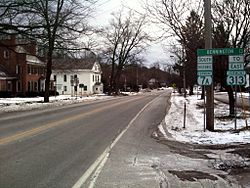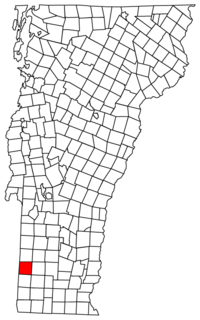Arlington, Vermont facts for kids
Quick facts for kids
Arlington, Vermont
|
|
|---|---|

Downtown Arlington
|
|

Arlington, Vermont
|
|
| Country | United States |
| State | Vermont |
| County | Bennington |
| Communities | Arlington East Arlington West Arlington |
| Area | |
| • Total | 42.4 sq mi (109.9 km2) |
| • Land | 42.2 sq mi (109.4 km2) |
| • Water | 0.2 sq mi (0.5 km2) |
| Elevation | 581 ft (177 m) |
| Population
(2020)
|
|
| • Total | 2,457 |
| • Density | 58/sq mi (22.4/km2) |
| Time zone | UTC−5 (Eastern (EST)) |
| • Summer (DST) | UTC−4 (EDT) |
| ZIP Codes |
05250 (Arlington)
05252 (East Arlington) |
| Area code(s) | 802 |
| FIPS code | 50-01450 |
| GNIS feature ID | 1462027 |
Arlington is a town in Bennington County, Vermont, United States. In 2020, about 2,457 people lived there.
Contents
History of Arlington
The town of Arlington was officially created on July 28, 1761. This happened when Benning Wentworth, the Governor of New Hampshire, granted the land. This area was part of what was known as the New Hampshire Grants. In 1777, Arlington became the very first capital of the Vermont Republic, which was an independent state before Vermont joined the United States.
Some of the first people to settle in Arlington were Captain Jehiel Hawley and his family. They arrived by 1764. They were Anglicans, a type of Christian faith. They had left Roxbury, Connecticut, because of strict rules from the main church there, the Congregational church. In 1764, the town decided to give 50 acres (about 20 hectares) of land to anyone who would build a gristmill in what is now East Arlington. A gristmill grinds grain into flour. Remember Baker, who was a cousin of the famous Ethan Allen, accepted this offer and built both a gristmill and a sawmill.
Before the American Revolution, both New York and New Hampshire claimed the land that is now Vermont. Arlington was mostly settled by Anglicans from Connecticut. Their land rights came from the New Hampshire Grants. When settlers with land grants from New York arrived, there were conflicts. The people of Arlington relied on a group called the Green Mountain Boys, led by Ethan Allen, to protect their land. The Green Mountain Boys were known for being strong and brave. They helped the New Hampshire settlers, even though the legal ownership of the land wasn't fully settled for many years.
Several members of the Green Mountain Boys lived in Arlington before the American Revolution. These included Thomas Chittenden, who later became Vermont's first governor, Seth Warner, and Remember Baker, who was the town's first clerk. Gideon Hard, who became a congressman for New York, was also born in Arlington. During the American Revolutionary War, the Patriot soldiers of the Green Mountain Boys fought against people who supported the British, known as Loyalists, in Arlington. Some British Loyalists in Arlington, led by Dr. Samuel Adams, even formed their own military group called Adams' Rangers. They fought for the British. In 1777, Adams' men fought at the Battle of Saratoga in New York but were defeated.
Geography and Climate
Arlington is located in the Valley of Vermont. It sits between two mountain ranges: the Taconic Range to the west and the Green Mountains to the east. Most of Arlington's land is within the Taconic Range. There are five main mountains in the town: Grass Mountain, Spruce Peak, The Ball (also called West Mountain), Red Mountain, and Big Spruce Mountain. Grass Mountain is the tallest, reaching about 3,109 feet (948 meters) high.
The town covers about 42.4 square miles (109.9 square kilometers). Most of this is land, with only a small part being water. The Battenkill river, famous for trout fishing, flows right through the middle of the town.
| Climate data for Arlington, Vermont | |||||||||||||
|---|---|---|---|---|---|---|---|---|---|---|---|---|---|
| Month | Jan | Feb | Mar | Apr | May | Jun | Jul | Aug | Sep | Oct | Nov | Dec | Year |
| Mean daily maximum °C | −1.9 | 0.9 | 4.9 | 12.4 | 18.8 | 24.1 | 25.8 | 25.1 | 20.9 | 14.1 | 7.7 | 1.3 | 12.9 |
| Daily mean °C | −7.2 | −5.3 | −1.0 | 5.9 | 11.9 | 16.9 | 19.2 | 18.3 | 13.8 | 7.7 | 2.7 | −3.4 | 6.7 |
| Mean daily minimum °C | −12.5 | −11.6 | −6.9 | −0.6 | 5.5 | 9.8 | 12.5 | 11.7 | 6.8 | 1.3 | −2.3 | −8.2 | 0.5 |
| Average precipitation mm | 86.4 | 71.1 | 91.4 | 88.9 | 109.2 | 119.4 | 116.8 | 111.8 | 96.5 | 109.2 | 101.6 | 101.6 | 1,201.4 |
| Average snowfall cm | 49.8 | 42.2 | 33.0 | 10.4 | — | — | — | — | — | 1.5 | 10.2 | 43.7 | 190.8 |
| Mean daily maximum °F | 28.6 | 33.6 | 40.8 | 54.3 | 65.8 | 75.4 | 78.4 | 77.2 | 69.6 | 57.4 | 45.9 | 34.3 | 55.2 |
| Daily mean °F | 19.0 | 22.5 | 30.2 | 42.6 | 53.4 | 62.4 | 66.6 | 64.9 | 56.8 | 45.9 | 36.9 | 25.9 | 44.1 |
| Mean daily minimum °F | 9.5 | 11.1 | 19.6 | 30.9 | 41.9 | 49.6 | 54.5 | 53.1 | 44.2 | 34.3 | 27.9 | 17.2 | 32.9 |
| Average precipitation inches | 3.40 | 2.80 | 3.60 | 3.50 | 4.30 | 4.70 | 4.60 | 4.40 | 3.80 | 4.30 | 4.00 | 4.00 | 47.30 |
| Average snowfall inches | 19.6 | 16.6 | 13.0 | 4.1 | — | — | — | — | — | 0.6 | 4.0 | 17.2 | 75.1 |
| Average precipitation days | 14.7 | 11.2 | 13.5 | 12.6 | 14.3 | 13.3 | 12.6 | 11.8 | 11.0 | 12.3 | 12.9 | 14.7 | 154.9 |
| Average snowy days | 10.6 | 8.7 | 7.3 | 2.3 | — | — | — | — | — | 0.4 | 3.0 | 9.0 | 41.3 |
Population Information
| Historical population | |||
|---|---|---|---|
| Census | Pop. | %± | |
| 1790 | 991 | — | |
| 1800 | 1,597 | 61.2% | |
| 1810 | 1,463 | −8.4% | |
| 1820 | 1,354 | −7.5% | |
| 1830 | 1,207 | −10.9% | |
| 1840 | 1,035 | −14.3% | |
| 1850 | 1,084 | 4.7% | |
| 1860 | 1,146 | 5.7% | |
| 1870 | 1,636 | 42.8% | |
| 1880 | 1,532 | −6.4% | |
| 1890 | 1,352 | −11.7% | |
| 1900 | 1,193 | −11.8% | |
| 1910 | 1,307 | 9.6% | |
| 1920 | 1,370 | 4.8% | |
| 1930 | 1,441 | 5.2% | |
| 1940 | 1,418 | −1.6% | |
| 1950 | 1,463 | 3.2% | |
| 1960 | 1,605 | 9.7% | |
| 1970 | 1,934 | 20.5% | |
| 1980 | 2,184 | 12.9% | |
| 1990 | 2,299 | 5.3% | |
| 2000 | 2,397 | 4.3% | |
| 2010 | 2,317 | −3.3% | |
| 2020 | 2,457 | 6.0% | |
| U.S. Decennial Census | |||
Based on the census from 2000, there were 2,397 people living in Arlington. These people lived in 1,009 households, and 676 of these were families. The town had about 56.5 people per square mile (21.8 people per square kilometer).
Most of the people in Arlington were White (98.08%). A small number were Black, Native American, Asian, or from other backgrounds. About 0.46% of the population was Hispanic.
Out of all the households, 28.5% had children under 18 living with them. More than half (56.3%) were couples who were married or in a civil union. About 8.1% of households were led by a female without a husband present. The average household had 2.38 people, and the average family had 2.90 people.
The population was spread out by age. About 23.0% were under 18 years old. About 16.5% were 65 years old or older. The average age in the town was 42 years.
Education
Arlington has schools for its young people. One of them is Arlington Memorial School, which is a high school with around 250 students.
Economy
One of the biggest employers for people living in Arlington is the Orvis company. Its main offices are in the nearby town of Sunderland. Mack Moulding is the largest employer right in Arlington.
Notable People
Many interesting people have lived in or come from Arlington:
- Samuel Adams – An early settler of Vermont and a British Loyalist during the American Revolution. He formed a military group called Adams' Rangers.
- Remember Baker – An early Vermont settler and a member of the Green Mountain Boys.
- Holly Bakke – A former Commissioner of Banking and Insurance in New Jersey.
- Alec Baldwin – A well-known actor who has a secondary home in Arlington.
- Thomas Chittenden – The first governor of Vermont and the first and third governor of the Vermont Republic.
- Martin Chester Deming – A businessman and member of the Vermont House of Representatives.
- Chick Evans – A baseball player.
- Dorothy Canfield Fisher – A famous author and educator. She helped bring the Montessori method of teaching to the United States. She lived and died in Arlington.
- Michael J. Fox – A famous actor who lived in Arlington and was married there.
- Gideon Hard – A former U.S. Congressman.
- Norman Rockwell – A very famous painter and illustrator, known for works like Willie Gillis, The Problem We All Live With, and Four Freedoms. He lived in Arlington.
- Carl Ruggles – A composer and painter.
- Seth Warner – An early Vermont settler and a member of the Green Mountain Boys.
Images for kids
-
The Battenkill as it flows through West Arlington
See also
 In Spanish: Arlington (Vermont) para niños
In Spanish: Arlington (Vermont) para niños




